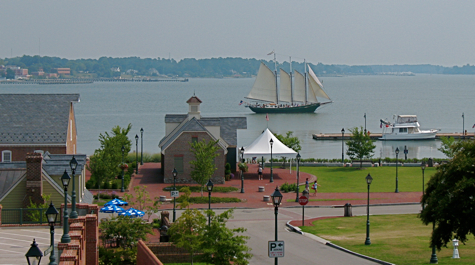“Science Under Sail” resumes April 18th on the York River
The Virginia Institute of Marine Science and Yorktown Sailing Charters will resume their unique “Science Under Sail” partnership on April 18, when the 105-foot schooner Alliance sets sail for the first of 5 spring-time cruises on the York River.
During each 2-hour cruise, guest scientists from VIMS will share their knowledge of Chesapeake Bay and its marine life with Alliance passengers. The vessel will sail between 2 pm and 4 pm on Wednesday afternoons from April 18 to May 30, with the exception of May 2nd and 9th.
The April 18 cruise will feature VIMS scientist Anu Frank-Lawale, who will explore oyster biology and the story behind the recent upsurge of oyster aquaculture in Chesapeake Bay.
The Alliance is a traditional 3-masted schooner built in 1995 by Treworgy Yachts in Palm Coast, Florida. She began plying the waters of the York River in 2005, when Greg and Laura Lohse established Yorktown Sailing Charters and began offering day-sail cruises from Yorktown’s Riverwalk Landing Pier, across the York River from VIMS. The 75-ton vessel can hold 49 passengers.
“Our inaugural Science Under Sail cruises last summer were very popular,” says Greg Lohse. “This year we decided to offer springtime cruises to avoid the summertime heat and experience the abundance of marine life as it moves back into the Bay following the winter.”
VIMS Dean and Director John Wells says the partnership “expands our outreach into a unique new setting,” and “offers a wonderful opportunity for VIMS scientists to share their knowledge of Chesapeake Bay and its marine life with the public.” He notes that the partnership “continues a long-standing maritime tradition of onboard naturalists that includes the likes of Joseph Banks and Charles Darwin.”
The impetus for the Science Under Sail partnership came from the Lohse’s experience with guests aboard the Alliance and its sister ship the Serenity frequently asking questions about the health of the Bay and its marine life. “We thought it would be great to build on that interest by establishing a partnership with VIMS that could help answer our guests’ questions and give them a better awareness of the Bay ecosystem,” says Laura Lohse.
During the second season of the partnership, guest scientists from VIMS will share their knowledge of oysters, Native American anglers, jellyfish and zooplankton, derelict or “ghost” crab pots, and marine robots. The presentations are designed to be as interactive as possible, with plans to include hands-on activities using nets and other scientific gear.
As with the other Alliance tours, passengers will first learn about the vessel itself, with a “setting sail” demonstration that describes the ship’s rigging and gives them the option to help lift the sails. Depending on time and passenger interest, the crew may also talk about the area’s rich history—the topic of the traditional Alliance cruises.
For more information on Yorktown Sailing Charters and the Alliance, visit www.sailyorktown.com. To sign up for a Science Under Sail cruise, visit www.zerve.com/SailYorktown/Science
Schedule of Topics, Science Under Sail 2012
Oysters on the Main Sail
(April 18, 2012) Anu Frank-Lawale, breeding research manager at the VIMS Shellfish Hatchery, discusses oyster biology and the story behind the recent upsurge of oyster aquaculture in Chesapeake Bay.
Native American Anglers
(April 25, 2012) VIMS outreach specialist Kattie McMillan describes the inventive methods—including hooks, nets, and spears—developed and used by Native Americans to access the rich marine resources of Chesapeake Bay.
Chesapeake Bay Drifters
(May 16, 2012) VIMS graduate student Josh Stone uses zooplankton netted from the York River to discuss the wonderful variety of Bay “drifters” and the important role these creatures play in marine ecology and food webs.
“Ghost” Pots in the Bay
(May 23, 2012) VIMS marine scientist David Stanhope examines how VIMS scientists and local watermen use sonar to locate derelict crab pots on the floor of Chesapeake Bay so they can be removed to protect marine life.
From HMS to ROV—the Past and Future of Marine Research
(May 30, 2012) Sailing ships like the schooner Alliance were once the pinnacles of marine technology. VIMS professor Mark Patterson leads a hands-on look at the next generation of marine research vehicles—underwater robots. Learn how these remotely operated vehicles (ROVs) and autonomous underwater vehicles (AUVs) are helping to advance marine science, environmental monitoring, and homeland security.

